Module 10 - Introduction to Wave Propagation, Transmission Lines, and Antennas
Pages i,
1-1,
1-11,
1-21,
1-31,
1-41,
2-1,
2-11,
2-21,
2-31,
2-40,
3-1,
3-11,
3-21,
3-31,
3-41,
3-51,
4-1,
4-11,
4-21,
4-31,
4-41,
4-51, Index
If you know the directions
of the E and H components, you can use the "right-hand rule" (see figure 2-6) to determine the direction of wave
propagation. This rule states that if the thumb, forefinger, and middle finger of the right hand are extended so
they are mutually perpendicular, the middle finger will point in the direction of wave propagation if the thumb
points in the direction of the E field and the forefinger points in the direction of the H field. Since both the E
and H fields reverse directions simultaneously, propagation of a particular wavefront is always in the same
direction (away from the antenna).
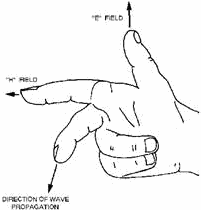
Figure 2-6. - Right-hand rule for propagation. Q8. If a transmitting antenna is placed close to the ground, how should the antenna be polarized to
give the greatest signal strength? Q9. In the right-hand rule for propagation, the thumb points in the
direction of the E field and the forefinger points in the direction of the H field. In what direction does the
middle finger point? ATMOSPHERIC PROPAGATION Within the atmosphere, radio waves
can be reflected, refracted, and diffracted like light and heat waves.
Reflection Radio waves may be reflected from various substances or objects they meet
during travel between the transmitting and receiving sites. The amount of reflection depends on the reflecting
material. Smooth metal surfaces of good electrical conductivity are efficient reflectors of radio waves. The
surface of the Earth itself is a fairly good reflector. The radio wave is not reflected from a single point on the
reflector but rather from an area on its surface. The size of the area required for reflection to take place
depends on the wavelength of the radio wave and the angle at which the wave strikes the reflecting substance.
When radio waves are reflected from flat surfaces, a phase shift in the alternations of the wave occurs. Figure
2-7 shows two radio waves being reflected from the Earth's surface. Notice that the positive and negative
alternations of radio waves (A) and (B) are in phase with each other in their paths toward the Earth's surface.
After reflection takes place, however, the waves are approximately 180 degrees out of phase from their initial
relationship. The amount of phase shift that occurs is not constant.
2-11
It depends on the polarization of the wave and the angle at which the wave strikes the reflecting
surface. Radio waves that keep their phase relationships after reflection normally produce a stronger signal at
the receiving site. Those that are received out of phase produce a weak or fading signal. The shifting in the
phase relationships of reflected radio waves is one of the major reasons for fading. Fading will be discussed in
more detail later in this chapter.

Figure 2-7. - Phase shift of reflected radio waves. Refraction Another phenomenon common to most radio waves is the bending of the
waves as they move from one medium into another in which the velocity of propagation is different. This bending of
the waves is called refraction. For example, suppose you are driving down a smoothly paved road at a constant
speed and suddenly one wheel goes off onto the soft shoulder. The car tends to veer off to one side. The change of
medium, from hard surface to soft shoulder, causes a change in speed or velocity. The tendency is for the car to
change direction. This same principle applies to radio waves as changes occur in the medium through which they are
passing. As an example, the radio wave shown in figure 2-8 is traveling through the Earth's atmosphere at a
constant speed. As the wave enters the dense layer of electrically charged ions, the part of the wave that enters
the new medium first travels faster than the parts of the wave that have not yet entered the new medium. This
abrupt increase in velocity of the upper part of the wave causes the wave to bend back toward the Earth. This
bending, or change of direction, is always toward the medium that has the lower velocity of propagation.
2-12
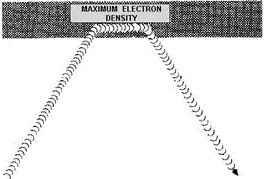
Figure 2-8. - Radio wave refraction. Radio waves passing through the atmosphere are affected by certain factors, such as temperature,
pressure, humidity, and density. These factors can cause the radio waves to be refracted. This effect will be
discussed in greater detail later in this chapter. Diffraction A radio wave that
meets an obstacle has a natural tendency to bend around the obstacle as illustrated in figure 2-9. The bending,
called diffraction, results in a change of direction of part of the wave energy from the normal line-of-sight
path. This change makes it possible to receive energy around the edges of an obstacle as shown in view a or at
some distances below the highest point of an obstruction, as shown in view B. Although diffracted RF energy
usually is weak, it can still be detected by a suitable receiver. The principal effect of diffraction extends the
radio range beyond the visible horizon. In certain cases, by using high power and very low frequencies, radio
waves can be made to encircle the Earth by diffraction.
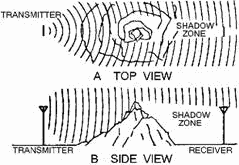
Figure 2-9. - Diffraction around an object. 2-13
Q10. What is one of the major reasons for the fading of radio waves which have been reflected from a
surface?
The EFFECT of The EARTH'S ATMOSPHERE ON Radio WAVES This discussion of electromagnetic wave propagation is concerned mainly with the properties and effects
of the medium located between the transmitting antenna and the receiving antenna. While radio waves traveling in
free space have little outside influence affecting them, radio waves traveling within the Earth's atmosphere are
affected by varying conditions. The influence exerted on radio waves by the Earth's atmosphere adds many new
factors to complicate what at first seems to be a relatively simple problem. These complications are because of a
lack of uniformity within the Earth's atmosphere. Atmospheric conditions vary with changes in height, geographical
location, and even with changes in time (day, night, season, year). a knowledge of the composition of the Earth's
atmosphere is extremely important for understanding wave propagation. The Earth's atmosphere is divided
into three separate regions, or layers. They are the TROPOSPHERE, the STRATOSPHERE, and the IONOSPHERE. The layers
of the atmosphere are illustrated in figure 2-10.

Figure 2-10. - Layers of the earth's atmosphere. TROPOSPHERE The troposphere is the portion of the Earth's atmosphere that
extends from the surface of the Earth to a height of about 3.7 miles (6 km) at the North Pole or the South Pole
and 11.2 miles (18 km) at the
2-14
equator. Virtually all weather phenomena take place in the troposphere. The temperature in this region
decreases rapidly with altitude, clouds form, and there may be much turbulence because of variations in
temperature, density, and pressure. These conditions have a great effect on the propagation of radio waves, which
will be explained later in this chapter. STRATOSPHERE The stratosphere is located
between the troposphere and the ionosphere. The temperature throughout this region is considered to be almost
constant and there is little water vapor present. The stratosphere has relatively little effect on radio waves
because it is a relatively calm region with little or no temperature changes. IONOSPHERE
The ionosphere extends upward from about 31.1 miles (50 km) to a height of about 250 miles (402 km). It contains
four cloud-like layers of electrically charged ions, which enable radio waves to be propagated to great distances
around the Earth. This is the most important region of the atmosphere for long distance point-to-point
communications. This region will be discussed in detail a little later in this chapter. Q11. What are
the three layers of the atmosphere? Q12. Which layer of the atmosphere has relatively little effect on
radio waves? Radio WAVE Transmission There are two principal ways in which
electromagnetic (radio) energy travels from a transmitting antenna to a receiving antenna. One way is by Ground
WAVES and the other is by SKY WAVES. Ground waves are radio waves that travel near the surface of the Earth
(surface and space waves). Sky waves are radio waves that are reflected back to Earth from the ionosphere. (See
figure 2-11.)
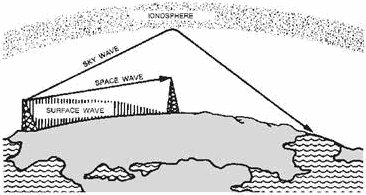
Figure 2-11. - Ground waves and sky waves. 2-15
Ground Waves The ground wave is actually composed of two separate component
waves. These are known as the SURFACE WAVE and the SPACE WAVE (fig. 2-11). The determining factor in whether a
ground wave component is classified as a space wave or a surface wave is simple. a surface wave travels along the
surface of the Earth. a space wave travels over the surface. SURFACE WAVE. - The surface
wave reaches the receiving site by traveling along the surface of the ground as shown in figure 2-12. a surface
wave can follow the contours of the Earth because of the process of diffraction. When a surface wave meets an
object and the dimensions of the object do not exceed its wavelength, the wave tends to curve or bend around the
object. The smaller the object, the more pronounced the diffractive action will be.
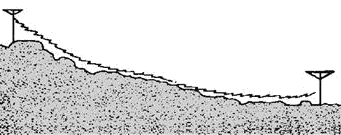
Figure 2-12. - Surface wave propagation. As a surface wave passes over the ground, the wave induces a voltage in the Earth. The induced voltage
takes energy away from the surface wave, thereby weakening, or attenuating, the wave as it moves away from the
transmitting antenna. To reduce the attenuation, the amount of induced voltage must be reduced. This is done by
using vertically polarized waves that minimize the extent to which the electric field of the wave is in contact
with the Earth. When a surface wave is horizontally polarized, the electric field of the wave is parallel with the
surface of the Earth and, therefore, is constantly in contact with it. The wave is then completely attenuated
within a short distance from the transmitting site. On the other hand, when the surface wave is vertically
polarized, the electric field is vertical to the Earth and merely dips into and out of the Earth's surface. For
this reason, vertical polarization is vastly superior to horizontal polarization for surface wave propagation.
The attenuation that a surface wave undergoes because of induced voltage also depends on the electrical
properties of the terrain over which the wave travels. The best type of surface is one that has good electrical
conductivity. The better the conductivity, the less the attenuation. Table 2-2 gives the relative conductivity of
various surfaces of the Earth.
2-16
Table 2-2. - Surface Conductivity

Another major factor in the attenuation of surface waves is frequency. Recall from earlier discussions
on wavelength that the higher the frequency of a radio wave, the shorter its wavelength will be. These high
frequencies, with their shorter wavelengths, are not normally diffracted but are absorbed by the Earth at points
relatively close to the transmitting site. You can assume, therefore, that as the frequency of a surface wave is
increased, the more rapidly the surface wave will be absorbed, or attenuated, by the Earth. Because of this loss
by attenuation, the surface wave is impractical for long- distance transmissions at frequencies above 2 megahertz.
On the other hand, when the frequency of a surface wave is low enough to have a very long wavelength, the Earth
appears to be very small, and diffraction is sufficient for propagation well beyond the horizon. In fact, by
lowering the transmitting frequency into the very low frequency (vlf) range and using very high-powered
transmitters, the surface wave can be propagated great distances. The Navy's extremely high-powered vlf
transmitters are actually capable of transmitting surface wave signals around the Earth and can provide coverage
to naval units operating anywhere at sea.
SPACE WAVE. - The space wave follows two distinct paths from the transmitting antenna to the
receiving antenna - one through the air directly to the receiving antenna, the other reflected from the ground to
the receiving antenna. This is illustrated in figure 2-13. The primary path of the space wave is directly from the
transmitting antenna to the receiving antenna. So, the receiving antenna must be located within the radio horizon
of the transmitting antenna. Because space waves are refracted slightly, even when propagated through the
troposphere, the radio horizon is actually about one-third farther than the line-of-sight or natural horizon.
2-17

Figure 2-13. - Space wave propagation. Although space waves suffer little ground attenuation, they nevertheless are susceptible to fading. This
is because space waves actually follow two paths of different lengths (direct path and ground reflected path) to
the receiving site and, therefore, may arrive in or out of phase. If these two component waves are received in
phase, the result is a reinforced or stronger signal. Likewise, if they are received out of phase, they tend to
cancel one another, which results in a weak or fading signal. Q13. What is the determining factor in
classifying whether a radio wave is a ground wave or a space wave? Q14. What is the best type of surface
or terrain to use for radio wave transmission? Q15. What is the primary difference between the radio
horizon and the natural horizon? Q16. What three factors must be considered in the transmission of a
surface wave to reduce attenuation? Sky Wave The sky wave, often called the
ionospheric wave, is radiated in an upward direction and returned to Earth at some distant location because of
refraction from the ionosphere. This form of propagation is relatively unaffected by the Earth's surface and can
propagate signals over great distances. Usually the high frequency (HF) band is used for sky wave propagation. The
following in-depth study of the ionosphere and its effect on sky waves will help you to better understand the
nature of sky wave propagation. STRUCTURE of The IONOSPHERE As we stated earlier,
the ionosphere is the region of the atmosphere that extends from about 30 miles above the surface of the Earth to
about 250 miles. It is appropriately named the ionosphere because it consists of several layers of electrically
charged gas atoms called ions. The ions are formed by a process called ionization.
2-18
Ionization Ionization occurs when high energy ultraviolet light waves from
the sun enter the ionospheric region of the atmosphere, strike a gas atom, and literally knock an electron free
from its parent atom. a normal atom is electrically neutral since it contains both a positive proton in its
nucleus and a negative orbiting electron. When the negative electron is knocked free from the atom, the atom
becomes positively charged (called a positive ion) and remains in space along with the free electron, which is
negatively charged. This process of upsetting electrical neutrality is known as IONIZATION. The free
negative electrons subsequently absorb part of the ultraviolet energy, which initially freed them from their
atoms. As the ultraviolet light wave continues to produce positive ions and negative electrons, its intensity
decreases because of the absorption of energy by the free electrons, and an ionized layer is formed. The rate at
which ionization occurs depends on the density of atoms in the atmosphere and the intensity of the ultraviolet
light wave, which varies with the activity of the sun. Since the atmosphere is bombarded by ultraviolet
light waves of different frequencies, several ionized layers are formed at different altitudes. Lower frequency
ultraviolet waves penetrate the atmosphere the least; therefore, they produce ionized layers at the higher
altitudes. Conversely, ultraviolet waves of higher frequencies penetrate deeper and produce layers at the lower
altitudes. An important factor in determining the density of ionized layers is the elevation angle of the
sun, which changes frequently. For this reason, the height and thickness of the ionized layers vary, depending on
the time of day and even the season of the year. Recombination
Recall that the process of ionization involves ultraviolet light waves knocking electrons free from their atoms. a
reverse process called RECombination occurs when the free electrons and positive ions collide with each other.
Since these collisions are inevitable, the positive ions return to their original neutral atom state. The
recombination process also depends on the time of day. Between the hours of early morning and late afternoon, the
rate of ionization exceeds the rate of recombination. During this period, the ionized layers reach their greatest
density and exert maximum influence on radio waves. During the late afternoon and early evening hours, however,
the rate of recombination exceeds the rate of ionization, and the density of the ionized layers begins to
decrease. Throughout the night, density continues to decrease, reaching a low point just before sunrise.
Four Distinct Layers The ionosphere is composed of three layers designated D, E, and F, from lowest level
to highest level as shown in figure 2-14. The F layer is further divided into two layers designated F1 (the lower
layer) and F2 (the higher layer). The presence or absence of these layers in the ionosphere and their height above
the Earth varies with the position of the sun. At high noon, radiation in the ionosphere directly above a given
point is greatest. At night it is minimum. When the radiation is removed, many of the particles that were ionized
recombine. The time interval between these conditions finds the position and number of the ionized layers within
the ionosphere changing. Since the position of the sun varies daily, monthly, and yearly, with respect to a
specified point on Earth, the exact position and number of layers present are extremely difficult to determine.
However, the following general statements can be made:
2-19
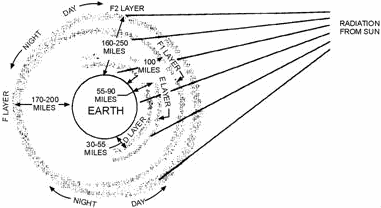
Figure 2-14. - Layers of the ionosphere. a. The D layer ranges from about 30 to 55 miles. Ionization in the D layer is low because it is the
lowest region of the ionosphere. This layer has the ability to refract signals of low frequencies. High
frequencies pass right through it and are attenuated. After sunset, the D layer disappears because of the rapid
recombination of ions. b. The E layer limits are from about 55 to 90 miles. This layer is also known as
the Kennelly- Heaviside layer, because these two men were the first to propose its existence. The rate of ionic
recombination in this layer is rather rapid after sunset and the layer is almost gone by midnight. This layer has
the ability to refract signals as high as 20 megahertz. For this reason, it is valuable for communications in
ranges up to about 1500 miles.
c. The F layer exists from about 90 to 240 miles. During the daylight hours, the F layer separates into two
layers, the F1 and F2 layers. The ionization level in these layers is quite high and varies widely during the day.
At noon, this portion of the atmosphere is closest to the sun and the degree of ionization is maximum. Since the
atmosphere is rarefied at these heights, recombination occurs slowly after sunset. Therefore, a fairly constant
ionized layer is always present. The F layers are responsible for high-frequency, long distance transmission.
Q17. What causes ionization to occur in the ionosphere? Q18. How are the four distinct layers of the
ionosphere designated? Q19. What is the height of the individual layers of the ionosphere?
REFRACTION IN The IONOSPHERE When a radio wave is transmitted into an ionized
layer, refraction, or bending of the wave, occurs. As we discussed earlier, refraction is caused by an abrupt
change in the velocity of the upper part of a radio wave as it strikes or enters a new medium. The amount of
refraction that occurs depends on three main factors: (1) the density of ionization of the layer, (2) the
frequency of the radio wave, and (3) the angle at which the wave enters the layer.
2-20
| - |
Matter, Energy,
and Direct Current |
| - |
Alternating Current and Transformers |
| - |
Circuit Protection, Control, and Measurement |
| - |
Electrical Conductors, Wiring Techniques,
and Schematic Reading |
| - |
Generators and Motors |
| - |
Electronic Emission, Tubes, and Power Supplies |
| - |
Solid-State Devices and Power Supplies |
| - |
Amplifiers |
| - |
Wave-Generation and Wave-Shaping Circuits |
| - |
Wave Propagation, Transmission Lines, and
Antennas |
| - |
Microwave Principles |
| - |
Modulation Principles |
| - |
Introduction to Number Systems and Logic Circuits |
| - |
- Introduction to Microelectronics |
| - |
Principles of Synchros, Servos, and Gyros |
| - |
Introduction to Test Equipment |
| - |
Radio-Frequency Communications Principles |
| - |
Radar Principles |
| - |
The Technician's Handbook, Master Glossary |
| - |
Test Methods and Practices |
| - |
Introduction to Digital Computers |
| - |
Magnetic Recording |
| - |
Introduction to Fiber Optics |
| Note: Navy Electricity and Electronics Training
Series (NEETS) content is U.S. Navy property in the public domain. |
|


















